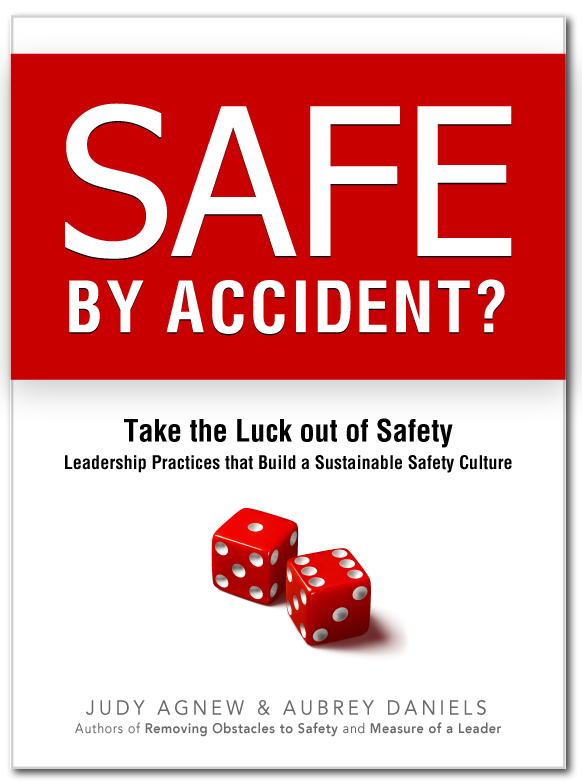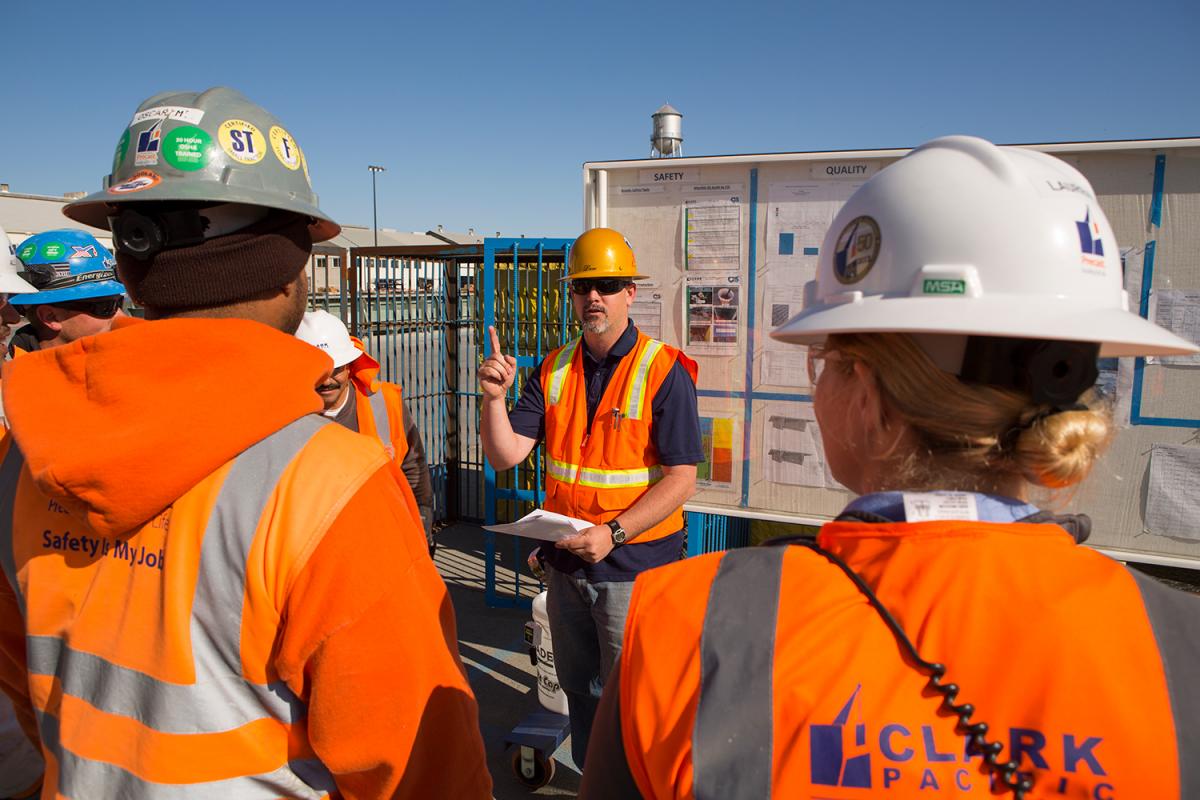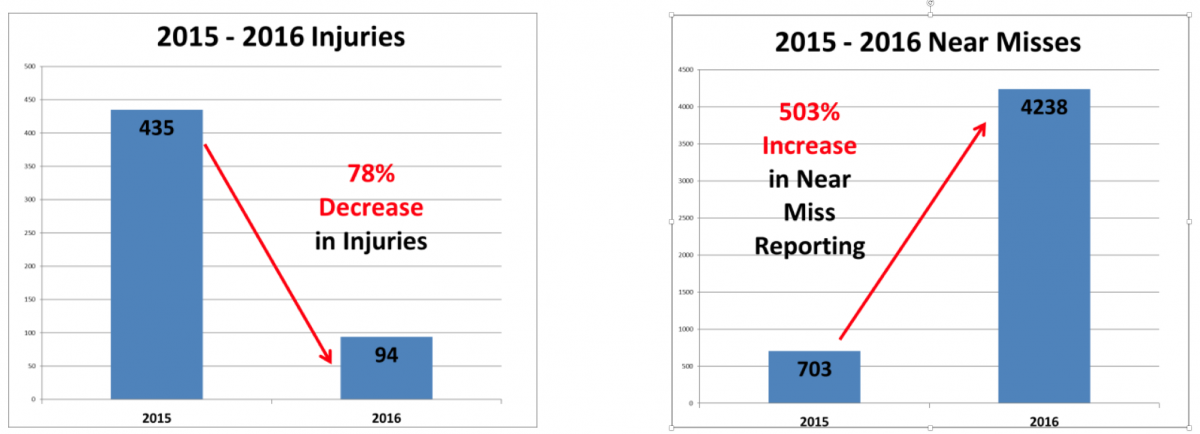Clark Pacific’s Safety Journey
High-rise hotels, hospitals, stadiums, student housing, churches, casinos, parking garages, all with an artistic flair: these are a few examples of the hundreds of structures that stand as the legacy of Clark Pacific, based in West Sacramento, California. This family business of over half a century specializes in producing and building with state-of-the-art concrete architectural and structural precast materials. A seven year construction project—the new, stellar Apple headquarters in Cupertino, California—is but one visual example of the quality products that come from Clark Pacific’s years of service and expertise.
“We have the experience and wisdom of a 50-year-old company with the mentality and enthusiasm of a start-up,” said Steve Voss, a 25-year employee and plant manager of the NorCal plant located in Woodland, California (one of three of the organization’s manufacturing facilities). Another major and continual project that began in earnest approximately one and a half years ago proves his point. That project is an approach to safety called Safety Leadership.
Until 2015, safety at Clark Pacific was, of course, a very important factor in day-to-day operations. But as Voss explained, “Even though our incident rate was below industry standards, that’s just not good enough. We knew we needed to do better. People were getting hurt and that’s unacceptable.”
Enter Audra Owens, now Director of Environmental, Health and Safety, who had in a previous position come across the book Safe by Accident: Leadership Practices that Build a Sustainable Safety Culture—a behavior-based approach to safe workplaces. The book, written by Judy Agnew and Aubrey Daniels of Aubrey Daniels International (ADI), impressed Owens, a safety professional of 20 years. “That book sparked a whole different way of thinking about how to approach safety,” Owens explained. She brought this vision with her to Clark Pacific, when one of the first steps she took was to have Bob Clark, President of Operations, read Safe by Accident.
A phrase on the book’s cover, “Take the luck out of safety,” resonated with Clark. He admits that his previous role in the company’s safety effort had been to hire safety personnel and remain available to them for consultation when necessary. “We had some good years with safety and our lost-time accidents. I just always knocked on wood when we were having a good year,” he said. “I’ve come a long, long way from there. I realized, like anything, if you want to do it, you’ve got to put your head down and work hard. It’s not about luck; it’s about a focused effort to come up with a good solution. With safety, it’s a journey. You’re never going to get to the end. Even though you might be doing great right now, you can get better. There’s something you can do every day to get better at it.”
Safety Leadership
 Safety Leadership is a positive approach designed to improve leader skills in changing safety-related behavior and promote safety engagement. It involves three general steps. First, identify important safety behaviors at all levels of the organization that will result in improvement. Second, strengthen those behaviors through daily, positive coaching interactions called touchpoints. Third, refine and improve coaching and positive reinforcement use through weekly accountability and debrief meetings. The process ensures everyone at every level is working in concert to achieve targeted safety results. At Clark Pacific, led by Owens and Bart Sevin, senior ADI consultant, the company identified four types of incidents to target first: hand and finger injuries, back injuries, live load violations (exposure of any body part under suspended loads), and crush-point violations. Simultaneously, they worked on increasing near-miss reporting in order to increase organizational learning.
Safety Leadership is a positive approach designed to improve leader skills in changing safety-related behavior and promote safety engagement. It involves three general steps. First, identify important safety behaviors at all levels of the organization that will result in improvement. Second, strengthen those behaviors through daily, positive coaching interactions called touchpoints. Third, refine and improve coaching and positive reinforcement use through weekly accountability and debrief meetings. The process ensures everyone at every level is working in concert to achieve targeted safety results. At Clark Pacific, led by Owens and Bart Sevin, senior ADI consultant, the company identified four types of incidents to target first: hand and finger injuries, back injuries, live load violations (exposure of any body part under suspended loads), and crush-point violations. Simultaneously, they worked on increasing near-miss reporting in order to increase organizational learning.
Through much hard work, Owens and the Safety Review Council (SRC) designed a near-miss reporting system using (among other elements) a newly created, pocket-sized notebook containing specific but easy guidelines for reporting near misses. In the months to follow, Owens, who is recognized by everyone on the team as key to the success of the safety process, worked to develop an intranet system that consolidated and shared near-miss reports, incident rates, and other integral information regarding the safety effort. “Safety is a team sport,” says Clark. “But having a great leader like Audra makes a lot of difference.”
Getting Started
 When Owens joined Clark Pacific she began with analysis of the safety activities and culture and conducted extensive interviews at every employee level. “I found there was no consistency and that told me we had a lot to do in building a safety culture,” she said. One question that she asked was, “Do you believe that all incidents and injuries are preventable?” The responses surprised her. “A very few people said, ‘Yes. I believe that,’” she commented. “Steve Voss was one of them.” And according to Voss, so was his assistant plant manager, Frank Kliewer. “He and I were singularly focused,” said Voss. “If you ask Frank if all injuries are preventable, he’ll beat me to it saying yes.”
When Owens joined Clark Pacific she began with analysis of the safety activities and culture and conducted extensive interviews at every employee level. “I found there was no consistency and that told me we had a lot to do in building a safety culture,” she said. One question that she asked was, “Do you believe that all incidents and injuries are preventable?” The responses surprised her. “A very few people said, ‘Yes. I believe that,’” she commented. “Steve Voss was one of them.” And according to Voss, so was his assistant plant manager, Frank Kliewer. “He and I were singularly focused,” said Voss. “If you ask Frank if all injuries are preventable, he’ll beat me to it saying yes.”
After Owens and plant safety champions Voss and Brad Williams, Southern California plant manager, attended a one-week, ADI class in Atlanta, they returned with added enthusiasm. “We took away a much broader understanding and application of all things behavior, understanding compliant level versus discretionary effort and what that science can unlock,” said Voss.
The next step was having Sevin train 57 leaders in the methods of behavioral safety leadership. Brief one-on-one, safety-focused interactions with direct reports called coaching touchpoints, are now part of the daily routine. At all levels, these brief discussions focus on providing feedback and recognition for the safety critical behaviors identified in the first stage of implementation. In regular meetings, from the top down, leaders conduct debriefs with their direct reports regarding their touchpoints and how they can all work to improve their coaching impact. In addition, weekly “toolbox talks” (company-wide communications to frontline employees regarding selected safe behaviors), and “safety moments” are now a mainstay at all of the Clark Pacific sites. This information is accessible along with the near-miss data on the company intranet Safety Incident Reporting Tracker (SIRT) system.
The Near-Miss System
 Clark compares the changed approach to safety and the safety culture to turning a large ship while Voss points out that top leadership absolutely must be on board to accomplish that goal. One of Owens’ first steps in doing just that was to create a successful near-miss reporting system. She explained, “If you don’t have a robust near-miss program, you’re missing the boat, because you will never know what your problems are and what you need to fix.”
Clark compares the changed approach to safety and the safety culture to turning a large ship while Voss points out that top leadership absolutely must be on board to accomplish that goal. One of Owens’ first steps in doing just that was to create a successful near-miss reporting system. She explained, “If you don’t have a robust near-miss program, you’re missing the boat, because you will never know what your problems are and what you need to fix.”
The near-miss reporting system has definitely become robust—supported by a positive culture change that rewards rather than punishes such reporting. Acknowledging that the drive toward incident prevention takes time in everyone’s busy day, Voss and other safety champions regularly consult with supervisors in the plants and field to hone the process. Recently the safety team developed a cell phone app for near-miss reporting. “We eliminated administrative time and the data is there in real time,” Voss said. “This, as part of our SIRT system, also helps us quickly respond to real-time metrics and that goes to reinforcing in a more immediate way.”
One of many examples where the safety leadership coaching process helped accelerate adoption of important safety-related behaviors was, in fact, around the near-miss system. Frank Kliewer, who reports directly to Voss, utilized coaching touchpoints and debrief meetings to drive near-miss reporting with his direct reports, who in turn used touchpoints to increase the number of near misses reported by their employees. According to Sevin, “Frank is one of many excellent practitioners of the safety leadership coaching process, and he provided an early example of how more effective coaching can be used to drive key safety behaviors—like reporting the near misses that Clark Pacific needed to help move the safety culture in the desired direction.”
Benchmarking Results
Many at Clark Pacific mention the change that must take place to emphasize and manage behavior rather than safety results. Today celebrations are held for meeting behavioral milestones (rather than lack of incidents), and that change has brought about significant results. “We’re striving for a self-directed workforce, an accident-free workplace,” Voss said. “Get past the mindset that an incident is just human error. That’s a very convenient, yet shallow root cause, and numbers (lagging indicators) represent real people who have gotten injured.”
Clark Pacific participates in a benchmarking group as one of five non-competitive precast concrete companies in the country. The groups meet and exchange information and best practices on a variety of issues in such areas as production, quality, finance, human resources, and, of course, safety. Clark Pacific recently hosted a tour of their facilities for their benchmarking partners which included an overview of their Safety Leadership program followed by actual involvement in the process.
“They were blown away because we showed the inverse correlation between near-miss reporting and our incident rate, and how it’s gone based on where we were and where we’ve come,” Voss explained. Between 2015 and 2016, near-miss reports rose by 503 percent while injuries decreased by 78 percent. “You see that correlation and it sells itself!” said Voss.

A Culture of Communication
Increased communication, data collection, feedback, and the regular message and activities from the top down that safety comes before any other consideration—all are changing the culture at Clark Pacific. Owens, Voss, and Clark can’t express enough the importance of leadership involvement and visible support in making this a successful initiative. “We put a feather in Bob Clark’s cap for getting people at all levels involved,” said Sevin.” He played a key role because he demonstrated the importance of the process by participating at his level on a consistent basis, and that’s critical.”
“Messaging is important,” Owens said. “We’re very much about meaningful and very deliberate communication around safety. We’ve branded One Company. One Life. Zero Injury. as our logo. I think when you have a passion and believe in this, others get on board when they see that it really makes a difference.”
Voss added, “Almost to a person, people are talking in a different language here. In my mind, that’s an affirmation that we’re seeing the culture change.”
The Journey
The people at Clark Pacific have come to the realization that safety is a never-ending effort, or as they often call it, “an ongoing journey.” Safety isn’t a box that can be checked off as finished, or a number that is satisfied with compliance to industry standards. Safety is about people and people are about behavior.
“The science of human behavior doesn’t change,” observed Voss. “What are you doing to ensure people will do the right thing even when you’re not there? In my opinion, this is the absolute best way to do it.”
Clark Pacific is planning to use these same methods in other areas such as quality. “We’re now understanding that the behavioral concepts don’t just apply to safety,” said Clark. “They apply to everything we’re doing here. It’s changed our culture. The big change for me personally is I realize this is my job, not just a token effort. I realize what we’re accomplishing and it’s one of the better things that I am doing in this company. The bottom line is that we really want our people safe and going home to their families the way they came to work. It’s the moral thing to do and the behavioral science behind it . . . I believe in it!”
How has Safety Leadership contributed to the safety process at Clark Pacific?"
“At our Fontana Plant, the Safety Leadership process as taught and followed correctly has allowed us to flow, like irrigation water, safety down to the line workers. In the past, much of the safety knowledge and learning stopped or was damned at the foreman/lead man level. The line workers often saw safety as a burden to getting their job done. Now those at the end of the row are getting all the water (information and practices water) and are growing. The workers appreciate the way safety is taught and shown to them through touchpoints and the debrief meetings are great for reinforcing and teaching the supervisors the right way to encourage safe practices.”
—Brad Williams, Plant Manager


